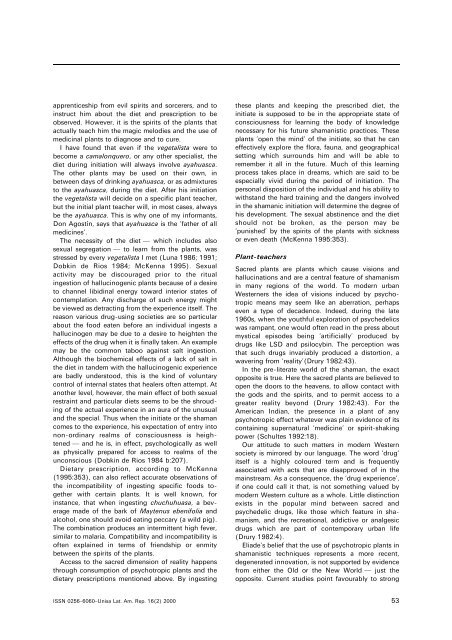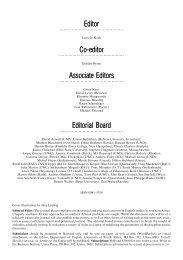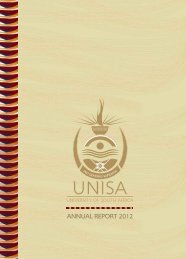pdf: 6.426kb - University of South Africa
pdf: 6.426kb - University of South Africa
pdf: 6.426kb - University of South Africa
You also want an ePaper? Increase the reach of your titles
YUMPU automatically turns print PDFs into web optimized ePapers that Google loves.
apprenticeship from evil spirits and sorcerers, and to<br />
instruct him about the diet and prescription to be<br />
observed. However, it is the spirits <strong>of</strong> the plants that<br />
actually teach him the magic melodies and the use <strong>of</strong><br />
medicinal plants to diagnose and to cure.<br />
I have found that even if the vegetalista were to<br />
become a camalonquero, or any other specialist, the<br />
diet during initiation will always involve ayahuasca.<br />
The other plants may be used on their own, in<br />
between days <strong>of</strong> drinking ayahuasca, or as admixtures<br />
to the ayahuasca, during the diet. After his initiation<br />
the vegetalista will decide on a specific plant teacher,<br />
but the initial plant teacher will, in most cases, always<br />
be the ayahuasca. This is why one <strong>of</strong> my informants,<br />
Don AgostõÂ n, says that ayahuasca is the `father <strong>of</strong> all<br />
medicines'.<br />
The necessity <strong>of</strong> the diet Ð which includes also<br />
sexual segregation Ð to learn from the plants, was<br />
stressed by every vegetalista I met (Luna 1986; 1991;<br />
Dobkin de Rios 1984; McKenna 1995). Sexual<br />
activity may be discouraged prior to the ritual<br />
ingestion <strong>of</strong> hallucinogenic plants because <strong>of</strong> a desire<br />
to channel libidinal energy toward interior states <strong>of</strong><br />
contemplation. Any discharge <strong>of</strong> such energy might<br />
be viewed as detracting from the experience itself. The<br />
reason various drug-using societies are so particular<br />
about the food eaten before an individual ingests a<br />
hallucinogen may be due to a desire to heighten the<br />
effects <strong>of</strong> the drug when it is finally taken. An example<br />
may be the common taboo against salt ingestion.<br />
Although the biochemical effects <strong>of</strong> a lack <strong>of</strong> salt in<br />
the diet in tandem with the hallucinogenic experience<br />
are badly understood, this is the kind <strong>of</strong> voluntary<br />
control <strong>of</strong> internal states that healers <strong>of</strong>ten attempt. At<br />
another level, however, the main effect <strong>of</strong> both sexual<br />
restraint and particular diets seems to be the shrouding<br />
<strong>of</strong> the actual experience in an aura <strong>of</strong> the unusual<br />
and the special. Thus when the initiate or the shaman<br />
comes to the experience, his expectation <strong>of</strong> entry into<br />
non-ordinary realms <strong>of</strong> consciousness is heightened<br />
Ð and he is, in effect, psychologically as well<br />
as physically prepared for access to realms <strong>of</strong> the<br />
unconscious (Dobkin de Rios 1984 b:207).<br />
Dietary prescription, according to McKenna<br />
(1995:353), can also reflect accurate observations <strong>of</strong><br />
the incompatibility <strong>of</strong> ingesting specific foods together<br />
with certain plants. It is well known, for<br />
instance, that when ingesting chuchuhuasa, a beverage<br />
made <strong>of</strong> the bark <strong>of</strong> Maytenus ebenifolia and<br />
alcohol, one should avoid eating peccary (a wild pig).<br />
The combination produces an intermittent high fever,<br />
similar to malaria. Compatibility and incompatibility is<br />
<strong>of</strong>ten explained in terms <strong>of</strong> friendship or enmity<br />
between the spirits <strong>of</strong> the plants.<br />
Access to the sacred dimension <strong>of</strong> reality happens<br />
through consumption <strong>of</strong> psychotropic plants and the<br />
dietary prescriptions mentioned above. By ingesting<br />
these plants and keeping the prescribed diet, the<br />
initiate is supposed to be in the appropriate state <strong>of</strong><br />
consciousness for learning the body <strong>of</strong> knowledge<br />
necessary for his future shamanistic practices. These<br />
plants `open the mind' <strong>of</strong> the initiate, so that he can<br />
effectively explore the flora, fauna, and geographical<br />
setting which surrounds him and will be able to<br />
remember it all in the future. Much <strong>of</strong> this learning<br />
process takes place in dreams, which are said to be<br />
especially vivid during the period <strong>of</strong> initiation. The<br />
personal disposition <strong>of</strong> the individual and his ability to<br />
withstand the hard training and the dangers involved<br />
in the shamanic initiation will determine the degree <strong>of</strong><br />
his development. The sexual abstinence and the diet<br />
should not be broken, as the person may be<br />
`punished' by the spirits <strong>of</strong> the plants with sickness<br />
or even death (McKenna 1995:353).<br />
Plant-teachers<br />
Sacred plants are plants which cause visions and<br />
hallucinations and are a central feature <strong>of</strong> shamanism<br />
in many regions <strong>of</strong> the world. To modern urban<br />
Westerners the idea <strong>of</strong> visions induced by psychotropic<br />
means may seem like an aberration, perhaps<br />
even a type <strong>of</strong> decadence. Indeed, during the late<br />
1960s, when the youthful exploration <strong>of</strong> psychedelics<br />
was rampant, one would <strong>of</strong>ten read in the press about<br />
mystical episodes being `artificially' produced by<br />
drugs like LSD and psilocybin. The perception was<br />
that such drugs invariably produced a distortion, a<br />
wavering from `reality'(Drury 1982:43).<br />
In the pre-literate world <strong>of</strong> the shaman, the exact<br />
opposite is true. Here the sacred plants are believed to<br />
open the doors to the heavens, to allow contact with<br />
the gods and the spirits, and to permit access to a<br />
greater reality beyond (Drury 1982:43). For the<br />
American Indian, the presence in a plant <strong>of</strong> any<br />
psychotropic effect whatever was plain evidence <strong>of</strong> its<br />
containing supernatural `medicine' or spirit-shaking<br />
power (Schultes 1992:18).<br />
Our attitude to such matters in modern Western<br />
society is mirrored by our language. The word `drug'<br />
itself is a highly coloured term and is frequently<br />
associated with acts that are disapproved <strong>of</strong> in the<br />
mainstream. As a consequence, the `drug experience',<br />
if one could call it that, is not something valued by<br />
modern Western culture as a whole. Little distinction<br />
exists in the popular mind between sacred and<br />
psychedelic drugs, like those which feature in shamanism,<br />
and the recreational, addictive or analgesic<br />
drugs which are part <strong>of</strong> contemporary urban life<br />
(Drury 1982:4).<br />
Eliade's belief that the use <strong>of</strong> psychotropic plants in<br />
shamanistic techniques represents a more recent,<br />
degenerated innovation, is not supported by evidence<br />
from either the Old or the New World Ð just the<br />
opposite. Current studies point favourably to strong<br />
ISSN 0256±6060±Unisa Lat. Am. Rep. 16(2) 2000 53

















